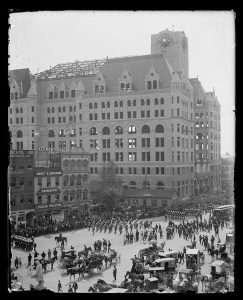
In the late Nineteenth Century, labor leaders in New York City organized the first Labor Day on September 5th, 1882. It was birthed in activism and a need to demonstrate the breath and composition of the local labor movement to politicians and business leaders alike. Workers took to the streets paraded and carried signs speaking out against monopolies, the right to strike and supporting workers’ rights to organize. They marched with banners stating, “Less Work and More Pay” and “To the Workers Should Belong All the Wealth.” With them were people holding the American Flag along with imagery of the Founding of the nation and the “Spirit of 76.” Later in the day, in what would become a tradition, marchers and supports ended up at Wendel’s Elm Park to enjoy a picnic, hear speeches and compete in a variety of athletic events. Along with these activities and interspersed with the America flag were flags representing Ireland, France and Germany to denote the variety of ethnic origins of the workers participating in the festivities. This was done at the first Labor Day to bring workers of different ethnic backgrounds together to march in a display of class solidarity.
Throughout the Nineteenth Century, the nation was swept with no only vicious displays of racism but nativism as well which the labor movement was not immune to in the least. So, it is remarkable that there was no prohibition for workers to march or display flags from their homelands, sing songs from their homelands or to cook ethnic foods at the picnic. There is no evidence that African American workers attended or were welcomed. Their press ignored their absence or their participation. Black workers did form their own unions but were discriminated against by these very organizations and employers in a Jim Crow movement and workplace. My guess is if they did attend they were invisible to the white labor leaders and rank and file and of course to the press that covered the event as well.
By 1886 the American Federation of Labor convinced its locals to sponsor Labor Day events each year as a workers’ holiday. And many large cities throughout the country hosted parades, speeches, athletic competitions and picnics. The holiday was not recognized widely except by the unions, workers and their supporters. Many laborers across the country boycotted work the first Monday of September and eventually forced businesses to close each year in conjunction with the holiday well before national recognition. By the end of the 1880s the AFL pushed out the more radical elements and sentiments connected with the labor movement to distinguish Labor Day as a day of reflection as opposed to May Day which was a yearly event to promote activism. By 1894 President Grover Cleveland and the US Congress adopted Labor Day as a national holiday in the wake of the Pullman Strike and an effort to demonstrate their sympathy to working class voters as they were inundated by critical publicity from the strike.
Throughout the Twentieth Century, Labor Day was practiced differently in every community. Large cities maintained the parades, the political speeches, the picnics and the competitive athletic events. Smaller communities hosted baseball games or other sporting events but more often than not just gave many workers and their families the day off. We are now in a place where the labor movement is at its lowest point since the Nineteenth Century. Labor Day started in 1882 to foster a sense of community to the workers and their organizations in New York City that represented workers of different ethnic backgrounds, languages and political beliefs. Although that fellowship was flawed due to bigotry within the movement, the first Labor Day did create a space where immigrants and American citizens alike could hope to create a common bond in the spirit of shared goals and interest. That first Labor Day and its moment was fleeting as labor leaders consciously redefined the holiday and pageantry of the events into an exercise of American nationalism. In most communities Labor Day has drifted away from the workers and unions it was attached to, and now represents a day off from work, mattress sales and prohibitions against wearing white until Easter. We no longer host parades, speeches or picnics as the founders of the holiday did, but I imagine if we did there would be more flags from around the world, more diverse voices, not only people of different ethnic backgrounds but working women and LGBTQ workers too. A diverse and larger display of people would be hosted in a 2017 celebration than in 1882. I would like to think we see some of that spirit in the protests we have seen against hatred, bigotry, nativism, racism, homophobia and sexism that have sprung forth to confront white supremacy in the past year. I attended the Pulse Memorial events in downtown Orlando both in 2016 and 2017 where I enjoyed seeing the flying of many flags, the singing of many songs and the faces of many different people. May we come together to celebrate our common spirit and come to appreciate our differences.
Dr. Robert Cassanello is an associate professor of History at the University of Central Florida. He has published articles in the Journal of Urban History, Florida Historical Quarterly and 49th Parallel. He is researching the racial integration and segregation of omnibuses, horsecars and streetcars in the United States during the 19th century. He is author of To Render Invisible: Jim Crow and Public Life in New South Jacksonville. He has co-edited two books, Florida’s Working-Class Past: Current Perspectives on Labor, Race, and Gender from Spanish Florida to the New Immigration with Melanie Shell-Weiss and Migration and the Transformation of the Southern Workplace since 1945 with Colin J. Davis.